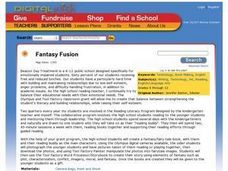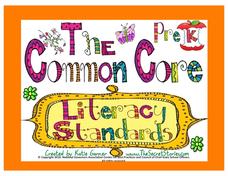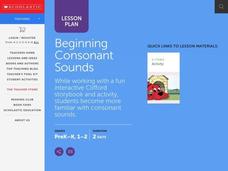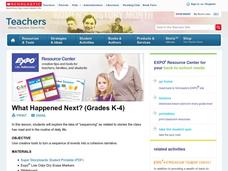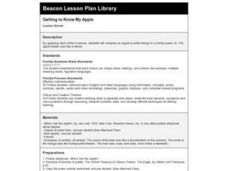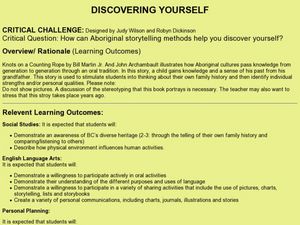Curated OER
Fantasy Fusion
Students create a fantasy/fairy tale book, with them and their reading buddy as the main characters. Using the Olympus digital cameras available, the older students photograph the younger students and have pictures taken of them reading...
Curated OER
Introduction To Pests
Students investigate common pests and match pests to their respective pictures. In a group discussion, students explore the basic needs of pests and share personal pest stories. They examine common self-protection measures. Using the...
Curated OER
The Common Core Literacy Standards - Pre-K Posters
Knowing the Common Core standards is a must for educators and learners alike. Here is an extensive set of literacy standards based on current kindergarten standards, but modified for learners in pre-school. The set includes display...
Curated OER
The Common Core Literacy Standards - Kindergarten Posters
Can we do it? Yes we can! Your class can become Common Core masters with a fine set of posters that state each of the kindergarten literacy standards in a friendly "we can" statement. Each of the posters contains two standards, a "we...
Curated OER
Beginning Consonant Sounds
Young readers practice their beginning consonant sounds. Solid worksheets prompt students to practice their consonant in fun ways. These worksheets use Clifford the Big Red Dog as a theme, and give the kids excellent and colorful practice.
Curated OER
Now That's a Problem!
Help learners improve multiplication skills by skip counting and creating their own multiplication word problems. They will begin by practicing skip counting and then illustrate word problems using a software program. Pixie is a software...
Curated OER
Palace Adventure
Young language arts learners write and illustrate a short fantasy story based on the book Corduroy. First, learners need to develop a character. Then, through their writing and illustrations, they take their characters on adventures...
Scholastic
What Happened Next? (Grades K-4)
Explore the structure of narrative writing with this fun, collaborative lesson. Start by reading aloud a short story, asking small groups of learners to fill in key events on a large story board prepared on the class whiteboard....
Curated OER
Getting to Know My Apple
First graders compare an apple to unlike things in a simile poem. ie: The apple tastes sour like a lemon. When poems are complete, have students share their simile poems with the class and finish eating their apples.
Curated OER
A Dreamer's Cloak
Students listen to the teacher read "A Dreamer's Cloak." They examine the difference between squares and circles and create their own cloak by using a paper bag and different shapes.
Curated OER
Patterned Leaf Cloths
Students identify and reproduce simple patterns (e.g., red blocks alternating with blue blocks; clap-clap-stamp) and create and extend simple patterns using a variety of materials or actions (e.g., popsicle sticks, pebbles, stickers,...
Curated OER
Creation of An Educational Toy, Game, or Story
Seventh graders create a toy, game or story suitable for a young child. They research magazines, catalogs, and child development texts for ideas. Students consider the age and development of the child.
Curated OER
Discovering Yourself
Students explore Aboriginal storytelling. In this literature lesson, students read Knots on a Counting Rope and then create a story line as they discuss the attributes of Aboriginal culture. Students retell the story in their own words.
Curated OER
Classroom Fun with Flat Stanley
Complete a series of activities based on the Flat Stanley books in this literature study activity. Introduce the book with a discussion of supernatural qualities, then studentscan create character webs, write news articles, build kites...
Curated OER
Confusable Letter Pairs
Students practice distinguishing between pairs of similar-looking lowercase letters, such as b and d, p and b, m and w, n and m. They distinguish between easily-confused letter pairs by reading and listening to a story that highlights...
Curated OER
Cloudy With a Chance of Meatballs
Fourth graders participate in a play to work on seeing events from a different perspective. Some of them are reporters, some cameramen and women, and others are interviewed. They put themselves in the shoes of the people in the book...
Curated OER
Reduce, Reuse, Recycle
Students understand the process of recycling. They investigate how it improves the environment. They read the story "Don't Pollute" by Stan and Jan Berenstein. They analyze trash and sort it into bins.
Curated OER
Gases Lighter and Heavier than Air
Young scholars explore the concept of air density. In this air density lesson, students fill balloons with helium and carbon dioxide. Young scholars determine which gases are heavier or lighter than air.
Curated OER
Something Fishy Going On
Students create a video animation of how Swimmy gathered his fish friends together to form a great big fish that would frighten the predator tuna away. In art class each child create a small red fish which gets displayed in the ocean...
Curated OER
Wolves and Penguins
Young scholars practice subtraction strategies and the use of number lines to count back. They use photographs of wolves and penguins to practice subtraction and the creation of number lines. Afterwards, they draw a wolf howling or a...
Curated OER
The Very Hungry Caterpillar
Learners read the book The Very Hungry Caterpillar and answer questions. In this Bloom's Taxonomy questioning instructional activity, students answer knowledge, comprehension, analysis , application and synthesis questions about the book...
Curated OER
My Favorite Animal and Me
Students research their favorite animal. They create their own fact book to share about their animal and their habitat.
Curated OER
Chinese Minority Cultures
Seventh graders identify the elements that characterize culture in literature.
Students analyze the representation of Chinese minority peoples
through textbooks. Students identify and interpret the differences among the people of China.
Curated OER
Town Mouse/ Country Mouse
Students recognize the difference between the city and the country. In this City Mouse, Country Mouse lesson, students listen to a story and describe and map differences between the city and the country. Students understand that people...
